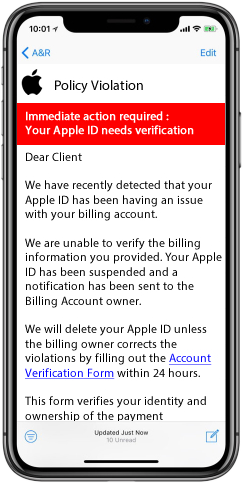Your Smartphone. Attacked.
- Details
- Written by Will from Holland
- Category: Articles

Your smartphone—right now—is probably the focus of scammers and hackers.
Fraudsters who used to focus on attacking your PC are now a lot more interested in smartphones since they are the most-used web device for a majority of people.
So, how do you keep your smartphone safe from hackers and scam software?
So, how do you keep your smartphone safe from hackers and scam software?
Short answer: It depends on the type of phone you use, and how you use that phone.
Most phones—regardless of make, model, and operating system—have a pretty solid security setup, which is a good thing. But security setups are worthless if you make mistakes, even just one time with a scam. Should you panic? No. If you put your foolproof skepticism to work, you'll be as safe as you can be. Start by learning to watch for the following three risks.
The 3 Biggest Risks
The 3 biggest risks for your smartphone:

Shady apps: You may be asked to install random apps when you surf questionable websites, but sometimes you can get them in the app stores too. These apps require an unnecessary amount of permissions, show tons of ads, trick you into purchasing add-ons, and the like. Or they may have ransomware or sophisticated cryptocurrency mining software inside them.
Phishing scams: Just like the good old "phishing scam" pushed through computers. Scammers can trick you into clicking a link and giving away personal, financial or login details. Scams like these may be much harder to detect on a cellphone. Check out the "Apple" scam example I received.
Jailbreaking (iOS) or rooting (Android): Ever thought about "unlocking" or "jailbreaking" your phone? Or have you already done this? When you unlock your phone, you may also accidentally remove your safety barrier. In addition to the potential dangers outlined in #1, this software uses extended permissions (accepted by default). Needless to say, you're then privy to many types of unexpected trouble.
Keep Your Smartphone Safe
How do you keep your smartphone safe?
-
Keep your phone and software up to date
Update your phone to the latest operating system and software, always. Not only does the developer add new items and remove bugs, they also take out vulnerabilities. -
Only download apps from within trusted stores
On Android devices, it's pretty easy to install software from outside of the Play Store. Apple's App Store is more strict and secure. Either phone is prone to risk though, as shady software can end up in a trusted app store. Security experts, however, mainly warn for software found outside.Be critical of apps you download! Known developers generally pose less risk, but may be pricier. And do you really need that extra flashlight app or QR code scanner even though your phone comes with one?
Be aware that amazing reviews don't always mean safe apps. Reviews can give you a snapshot overview of the good and the bad, for sure. However, some apps with 5-star ratings, and comments like "Yes!", "OK!", and "Buy" may be sketchy.
-
Carefully look at app permissions
After installation, certain apps ask for your permission to see your contacts, camera, location or microphone. Consider whether your app needs to be reading your email or text messages, or if it just wants to market you. -
Consider a virus scanner (Android)
Viruses target Android cellphones. Your provider probably offers free software. Find out now, to be sure. Cheap or free software is offered everywhere, but be careful where you get it from. Do proper research before downloading anything.
How to Recognize Shady Software
How do I know if I've got shady software on my phone?
Good question... because many times, people have no idea. But here are some indicators:
Phones may react slow when infected (especially when it "suddenly" starts acting slow after installing a new app), but it is no given.
When your apps show a ridiculous amount of ads, that's a pretty good red flag.
When apps from a trusted provider (YouTube, Instagram, Tumblr, etc.), pop up a box asking for credit card information, you know you're infected.
If you're being asked for fingerprint confirmation (to gauge your heartrate, for instance). Recently, multiple iOS apps were affected by this. Scammers ultimately used the fingerprint for charge authorizations.
Although malware may be invisible, if you have an app icon that is unclickable, remove it, just to be sure. It may be a sign of shady software.
Is Your Phone Infected or Hacked?
What to do if you think you've been infected or hacked.
Android users should scan for viruses. Immediately install a virus scanner and scan your device: Delete or isolate the threat. For iOS devices, removing the app should be sufficient.
If you're device is seriously affected, you may have to reset to factory settings and start fresh. Additionally, you can take your phone into a provider or retailer shop for help.
Be a skeptic when you're looking at any communication on your smartphone. When in doubt, do not use! Those two sentences summarize the best defense you have from these scammers and hackers.
I hope this info keeps your phone safe and free from scammers, hackers and viruses. Good luck!
Cheers, Will












